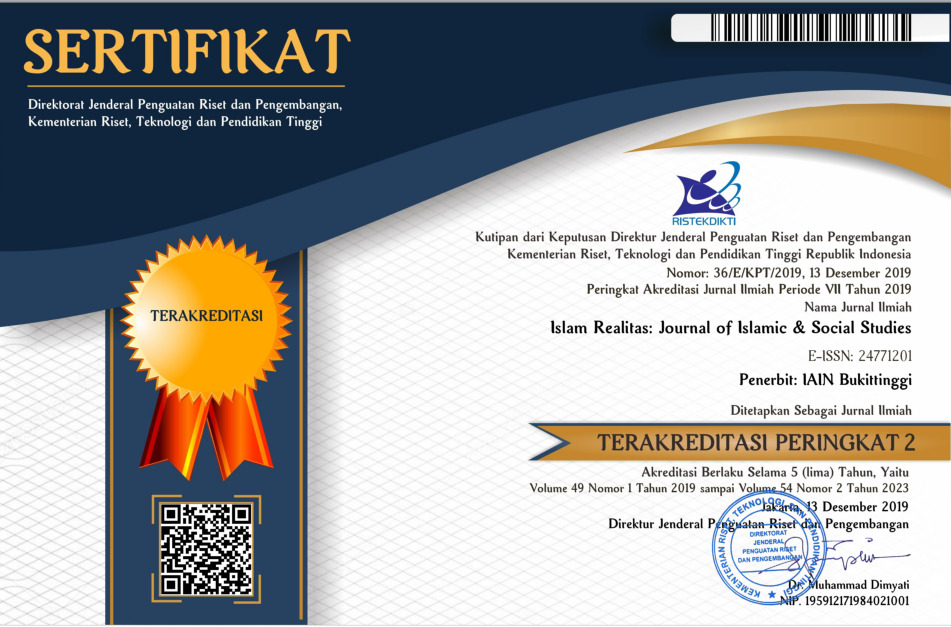The Polemic of Isra' Mi'raj in the Perspective of Mu'tazilite and Sunni Tafsir: A Comparative Study of Al-Kasshaf and Al-Kabir
DOI:
https://doi.org/10.30983/fuaduna.v8i2.9099Keywords:
Isra' Mi'raj, Tafsir, Al-Zamakhshari, Al-Razi, Comparative AnalysisAbstract
This study examines the Isra' Mi'raj, the miraculous nocturnal journey of the Prophet Muhammad, through the lens of the tafsir interpretations of Al-Zamakhshari and Al-Razi, with a focus on the differing views of these two prominent scholars. The event, which encompasses the Prophet's journey from the Al-Haram Mosque to the Al-Aqsa Mosque and his ascension to Sidaratul Muta, where he directly encountered Allah SWT, has been subject to diverse theological and interpretative discussions. This article employs a descriptive and qualitative methodology, utilizing library research for data collection and content analysis to examine the relevant tafsīr texts. The comparative analysis reveals that Al-Zamakhshari asserts the event took place at the Al-Haram Mosque in a spiritual form, prior to the Prophet's prophethood, whereas Al-Razi posits that the Isra' Mi'raj occurred in the general Haram area, specifically in the house of Umm Hani bint Abi Talib, a year before the Hijrah, and involved both body and spirit. The study further explores the interpretive approaches of both mufassirun, highlighting differences in their methods, theological beliefs, the location of departure, the timing of the event, and the nature of the ascension itself. These findings contribute to a deeper understanding of the variances in the interpretations of this pivotal event in Islamic tradition.
References
Al-Ayyubi, S. (2019). Hubungan Filsafat Dan Bahasa Arab (Studi Tentang Keterkaitan Filsafat Dan Bahasa Arab). Fikroh: Jurnal Pemikiran Dan Pendidikan Islam, 12(1), 54.
Al-Razi, F. al-D. (2012). al-Tafsir al-Kabir aw Mafatih al-Ghaib. Dar al-Hadis.
Al-Zamakhsari. (2015). Tafsir al-Kasyaf. Dar al-Kutub al-Ilmiyah.
Ali, Z. M. (2022). Melacak Bentuk Tafsir Tematik dalam Khazanah Tafsir Klasik: Studi Bentuk Tafsir Tematik dalam Kitab Tafsir Al-Tabari dan Ibnu Katsir. Ulumul Qur’an: Jurnal Kajian Ilmu Al-Qur’an Dan Tafsir.
Anam, M. (2020). Tafsir Modern di Iran. Al-I’jaz : Jurnal Studi Al-Qur’an, Falsafah Dan Keislaman, 2(2). https://doi.org/10.53563/ai.v2i2.38
Azhari, A. (2022). Filsafat Islam: Telaah Tentang Korelasi Epistemologi Al Quran dan Sains Modern. TADRIBUNA: Journal of Islamic Education Management, 3(1). https://doi.org/10.61456/tjiec.v3i1.56
Fuadi, M. A. (2016). Ayat-Ayat Pertanian dalam Al-Quran (Studi Analisis Terhadap Penafsiran Thanthawi Jauhari dalam Kitab Al-jawahir fī Tafsir Al-Qur’an Al-Karim). In Islamic State University Walisongo Semarang.
Furqan, F. (2023). Metodologi Tafsir Jami’ al-Bayan Imam Thabari. TAFSE: Journal of Qur’anic Studies, 8(1). https://doi.org/10.22373/tafse.v8i1.18397
Hamka. (1989). Tafsir Al-Azhar (Jilid 1). Pustaka Nasional Pte Ltd Singapura.
Hannan, A. (2021). The Resistance of Conservative Islamic Organizations on the Development of Regional Tourism in Madura. Jurnal Fuaduna : Jurnal Kajian Keagamaan Dan Kemasyarakatan, 5(1). https://doi.org/10.30983/fuaduna.v5i1.4198
Haris, A. (2015). Tafsir Tentang Peristiwa Isra’ Mi‘Raj. TAJDID: Jurnal Ilmu Ushuluddin, 14(1). https://doi.org/10.30631/tjd.v14i1.22
Herlina, & Syarifuddin. (2022). Nilai-nilai Pendidikan dalam Shalat: Kajian Tafsir dan Fikih. Instructional Development Journal, 5(3).
Iqbal, M., & Ja’far, J. (2019). Contemporary Development Of Qur’anic Exegesis In Indonesia And Iran. Journal of Contemporary Islam and Muslim Societies, 3(1). https://doi.org/10.30821/jcims.v3i1.4144
Jumini, S. (2016). Teori ketidakpastian Heisenberg dalam Peristiwa Isro’Mi’roj. Prosiding SNPS (Seminar Nasional Pendidikan Sains), 3.
Kamalia, W. (2017). Literatur tafsir indonesia (Analisis Metodologi dan Corak Tafsir Juz ’Amma As-Siraju ’l Wahhaj Karya M. Yunan Yusuf). Tafhim: Ikim Journal of Islam.
Khamid, A. (2024). Islam dan Migrasi Manusia (Tafsir Al-Isra’ Ibnu Asyur : 70 dan Yasin : 41). Indonesian Journal of Islamization Studies, 1(2). https://doi.org/10.21111/injas.v1i2.11219
Khoirul Muhtadin, & Serli Ratna Sari. (2023). Batasan Akal Mufassir (Analisis Pemikiran Al-Ghumari Tentang Sebab Kesalahan Tafsir). SETYAKI : Jurnal Studi Keagamaan Islam, 1(2). https://doi.org/10.59966/setyaki.v1i2.405
Malik, N. H. A., & Komarudin, E. (2023). Perbandingan Metodologi Tafsir terhadap Ayat-Ayat Peristiwa Isra’ Mi’raj Nabi Muhammad SAW. Jurnal Iman Dan Spiritualitas, 3(2). https://doi.org/10.15575/jis.v3i2.29282
Mulyaden, A., Hilmi, M. Z., & Yunus, B. M. (2022). Manhaj Tafsir Al-Kasyaf Karya Al-Zamakhsyari. Jurnal Iman Dan Spiritualitas, 2(1). https://doi.org/10.15575/jis.v2i1.16492
Nasokah, N. (2018). Tafsir Muqaran Ibnu Katsir Dan Al-Maraghi Q.S. AL-ISRA’: 1. Manarul Qur’an: Jurnal Ilmiah Studi Islam, 18(2). https://doi.org/10.32699/mq.v18i2.946
Nastiar, M. A., & Miski, M. (2023). Ṭabaqat al-Mufassirin by al-Suyuṭi and the Affirmation of Non-Sunni Mufassir Authority: A Historiographical Analysis. QOF, 7(2). https://doi.org/10.30762/qof.v7i2.1159
Nur Muhammad, H., Suwarno, S., & Fauziah, A. (2021). Taqiyyah dalam Pandangan Sunni dan Syi’ah (Studi Analisis Komparatif Kitab Tafsir Al-Qurtubi dan Al-Mizan). Ulumul Qur’an: Jurnal Kajian Ilmu Al-Qur’an Dan Tafsir, 1(2). https://doi.org/10.58404/uq.v1i2.71
Rahman, O., & Rahman, M. G. (2020). Tafsir Ideologi: Bias Idiologi dalam Tafsir Teologi Sunni, Muktazilah, dan Syiah. As-Syams: Journal Hukum Islam, 1(2).
Roni, M. (2021). Konsep Nur Muhammad Studi Penafsiran Surat An Nur Ayat 35. Al Kauniyah, 2(1).
Rosyadi, S. (2019). Model Nalar Burhânî dalam Madzhab Tafsir Teologimu’Tazilah. Jurnal Al-Fath, 13(1).
Saladin, B. (2013). Pro dan Kontra Penafsiran Zamakhsyari Tentang Teologi Mu’tazilah Dalam Tafsir Al-Kasysyaf. AL-IHKAM: Jurnal Hukum & Pranata Sosial, 5(1). https://doi.org/10.19105/al-lhkam.v5i1.279
Saputra, A., & Balqis. (2022). Penafsiran Surat Al- ‘ Ashr Dalam Tafsir Al-Maragi Interpretation of Surah Al-Ashr in Tafsir Al-Maraghi. Jurnal Studi Al-Quran Dan Hadis, 6(1).
Sujani, E. H., & Ichsan, I. (2022). The Effect of Muri-Q Method on the Ability of Tahfizh al-Qur’an in Early Childhood. Jurnal Fuaduna: Jurnal Kajian Keagamaan Dan Kemasyarakatan, 6(1). https://doi.org/10.30983/fuaduna.v6i1.5149
Supriadi, S. (2022). Studi Tafsir Al-Maraghi Karya Ahmad Musthafa Al-Maraghi. Jurnal Asy-Syukriyyah, 16(1). https://doi.org/10.36769/asy.v16i1.218
Tajuddin, M., Mildawati, T., & Masrifah, R. (2021). Ayat-Ayat Sains Dalam Al-Qur’an. Jurnal Teknologi Pendidikan Madrasah, 4(2).
Wathani, S. (2018). Al-I’tizalat Dalam Tafsir Anwar Al-Tanzil Wa Asrar Al-Ta’wil Karya Al-Baiḍawi. El-’Umdah, 1(1). https://doi.org/10.20414/el-umdah.v1i1.411
Wijaya, S., & Mochamad, Z. F. (2022). Konsep Ta`Wil Sunni-Muktazilah (Studi Analisis Ayat-Ayat Mutasyabihat Dalam Mafatih Al-Ghaib Karya Fakhruddin Al-Razi Dan Tanzih Al-Qur’an ‘An Al-Mathaʻin Karya Qadli ʻabdul Jabbar). Hikami : Jurnal Ilmu Alquran Dan Tafsir, 3(1). https://doi.org/10.59622/jiat.v3i1.60
Zakaria, A. (2019). Isra Mi’raj Sebagai Perjalanan Religi: Studi Analisis Peristiwa Isra Mi’raj Nabi Muhammad Menurut Al Qur’an dan Hadits. Al - Tadabbur: Jurnal Ilmu Al-Qur’an Dan Tafsir, 4(01). https://doi.org/10.30868/at.v4i01.428
Zuhdi, M. H. (2015). Fiqh al-bi’ah: Al-Adalah, 7(4).
Zulfikar, E. (2019). Memperjelas Epistemologi Tafsir Bi Al-Ma’tsur (Aplikasi Contoh Penafsiran dalam Jami’ al-Bayan Karya al-Tabari). Jurnal At-Tibyan: Jurnal Ilmu Alquran Dan Tafsir, 4(1). https://doi.org/10.32505/tibyan.v4i1.835.
Downloads
Published
Issue
Section
Citation Check
License
Copyright (c) 2024 Misbakhul Arifin, Musyarrofah Musyarrofah, Abd. Kholid

This work is licensed under a Creative Commons Attribution-ShareAlike 4.0 International License.
Authors who publish with this journal agree to the following terms:
- Authors retain copyright and grant the journal right of first publication with the work simultaneously licensed under a Creative Commons Attribution-ShareAlike 4.0. that allows others to share the work with an acknowledgment of the work's authorship and initial publication in this journal.
- Authors are able to enter into separate, additional contractual arrangements for the non-exclusive distribution of the journal's published version of the work (e.g., post it to an institutional repository or publish it in a book), with an acknowledgment of its initial publication in this journal.
- Authors are permitted and encouraged to post their work online (e.g., in institutional repositories or on their website) prior to and during the submission process, as it can lead to productive exchanges, as well as earlier and greater citation of published work (See The Effect of Open Access).






